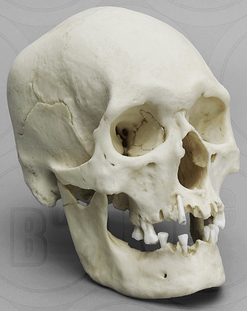Mensch: Schädel
Schädel polynesischer Herkunft
Homo sapiens
Schädel vermutlich polynesischer Herkunft. Der Zahnzustand ist sehr schlecht (nur 12 von 32 Zähnen vorhanden). Es gibt Hinweise auf Parodontalerkrankungen sowie Karies, Zahnfrakturen und Zahnverlust zu Lebzeiten. Das Kiefergelenk wurde aufgrund des breiten Bewegungsspielraums, der zum Kauen mit wenigen Zähnen notwendig ist, angepasst.
Separater Ständer auf Anfrage erhältllich (Artikel S-BC-302)
Beschrieb in Englisch:
Cranial measurements taken by the Maxwell Museum suggest that this skull is likely of Polynesian heritage. The sagittal keel, parietal bossing, the broad, prominent basiooccipital, and the rocker jaw are all excellent for comparison purposes with skulls from other populations. The distinctive rocker jaw is curved along the inferior surface of the mandible with a much smaller section making contact with a plane surface than is found in the mandibles of other groups. The dental condition is extremely poor (only 12 of 32 teeth remain). There is evidence of periodontal disease as well as caries, antemortem fractures and antemortem tooth loss. The temporomandibular joint (TMJ) is modified because of the wide range of motion necessary for chewing with few teeth. The dental condition provides an example of TMJ modification resulting from tooth loss and unorthodox occlusion. We thank the Maxwell Museum for the opportunity to cast this specimen. For an osteological evaluation report (PDF), a copy of which will be sent with the purchase of this specimen, go to BC-302-Report. 2-part skull (separate cranium & jaw).
Beschrieb in Englisch:
Cranial measurements taken by the Maxwell Museum suggest that this skull is likely of Polynesian heritage. The sagittal keel, parietal bossing, the broad, prominent basiooccipital, and the rocker jaw are all excellent for comparison purposes with skulls from other populations. The distinctive rocker jaw is curved along the inferior surface of the mandible with a much smaller section making contact with a plane surface than is found in the mandibles of other groups. The dental condition is extremely poor (only 12 of 32 teeth remain). There is evidence of periodontal disease as well as caries, antemortem fractures and antemortem tooth loss. The temporomandibular joint (TMJ) is modified because of the wide range of motion necessary for chewing with few teeth. The dental condition provides an example of TMJ modification resulting from tooth loss and unorthodox occlusion. We thank the Maxwell Museum for the opportunity to cast this specimen. For an osteological evaluation report (PDF), a copy of which will be sent with the purchase of this specimen, go to BC-302-Report. 2-part skull (separate cranium & jaw).




Hersteller:
| Bone Clones |  |
Alle Preise zuzüglich MwSt und Versandkosten

